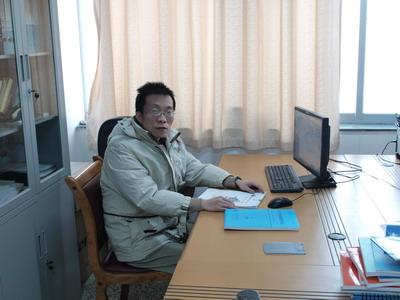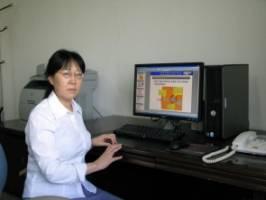The selection for the 2009 Gansu Science and Technology Award winners has been accomplished recently. Two Institute of Modern Physics, CAS (IMP) projects win the first prize in natural science and the first prize for S&T Advancement respectively.
 |
|
Prof. ZUO Wei at work ----Photo by IMP |
Study on Theories of Nucleus Microscopic Many-body and Properties of Isospin Asymmetric Nuclear Matter, performed by Profs. ZUO Wei and LIU Jianye, took the first place of the two first prizes in natural science.
Applied Study on Relationship between Active Oxygen Free Radicals and Urinary System Tumor, Calculus and Male Infertility, performed jointly by Prof. ZHANG Hong from IMP (second author) and the second hospital attached to Lanzhou University, wins the first prize for Gansu Science & Technology Advancement.
The awarded research work by Profs. ZUO Wei and LIU Jianye covers the fields of nuclear physics, heavy ion physics and nuclear-astrophysics. The nuclear microscopic many-body Brueckner-Hartree-Fock (BHF) theory has been developed from several aspects in the study.
The inner thermal consistency and the predicted saturation properties of nuclear matter have been improved remarkably. An extended isospin-dependent BHF approach has been established by including a microscopic three-body force and the effect of the ground-state correlations.
The rearrangement contribution of the microscopic three-body force has been derived and calculated within the framework of the Brueckner theory for the first time in the world. Based on the improved BHF approach, the equation of state and the single-particle properties of isospin asymmetric nuclear matter have been investigated systematically.
Prof. ZHANG Hong----Photo by IMP
A number of important new results are obtained and some long-standing problems in nuclear many-body approaches have been solved. The TBF effect on the 1S0 proton superfluidity in neutron stars has been explored for the first time. It has been shown that the microscopic TBF suppresses strongly the 1S0 proton superfluidity in neutron stars and new strength parameters of the 1S0 proton pairing gap in beta-stable neutron star matter has been predicted for the study of neutron star cooling.

By using the IQMD model, the isospin effect in heavy ion collisions has been investigated systematically. It has been shown for the first time that the nuclear stopping is a promise probe for extracting information of in-medium nucleon-nucleon cross sections.
The main results of the above awarded research work have been published in well-known international journals such as Phys. Rev. Lett, Phys. Lett. B, Phys. Rev. C, Eur. Phys. J., and have been cited more than 300 times by other scientists in the SCI journals.
Related News
Photos
More>>trade
- Dinosaurs with Bird-like Wrists
- IMHE Makes New Progress on UAV Aerial Remote Sensing Technology and Application
- IHB Researchers Rescue Yangtze Finless Porpoises in Poyang Lake
- EurekAlert!: Dark Age For China s Winged Dinosaurs Ends With Renaissance Of Long
- Superconducting Magnet Technology Center Established in Weifang
market
- RS-based Studies of Post-Earthquake Conditions in Wenchuan
- Exceptional Dinosaur Fossils Show Ontogenetic Development of Early Feathers
- CAS Launches High-Performance Distributed GPU Supercomputing System
- U.S., Russian Scientists Cooperate with Scientists of IHB on Research of Yangtze
- CAS Sends Rescue Team to the Earthquake-Stricken Yushu County
finance
- CEODE Obtained First Batch High-resolution Airborne Remote Sensing Data of Yushu
- AIOFM s Atmospheric Environment Monitoring System to Escort the World Expo 2010
- 2010 Tan Kah Kee Science Award Conferred in Beijing
- Quantum Teleportation Achieved over 16 km
- CAS Researchers Make Breakthrough in Hyper-Entangled Schr dinger Cat State





